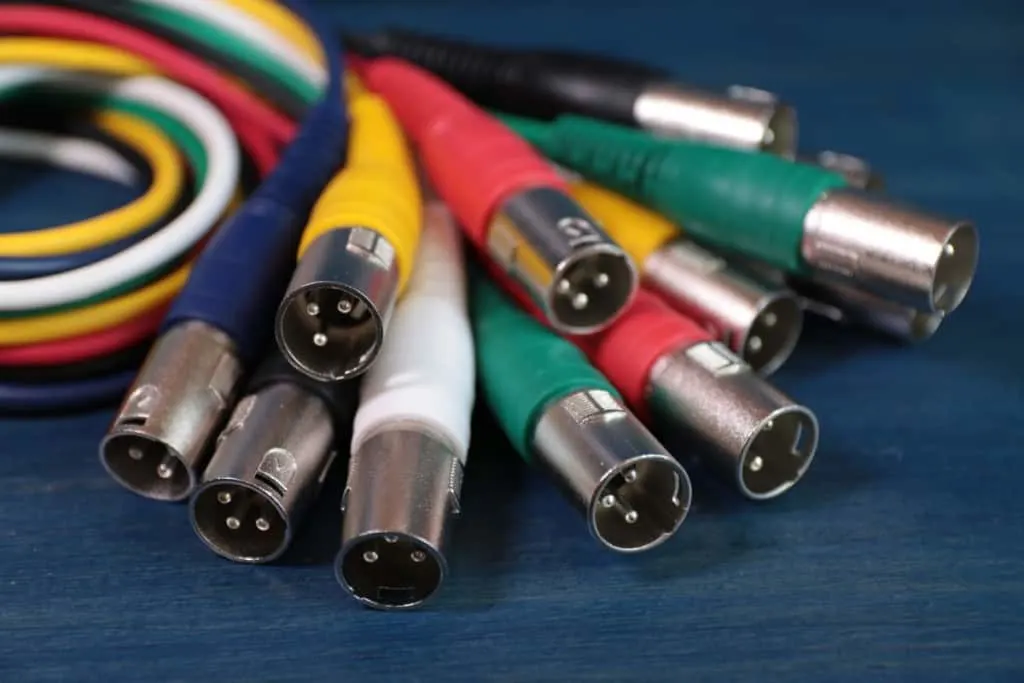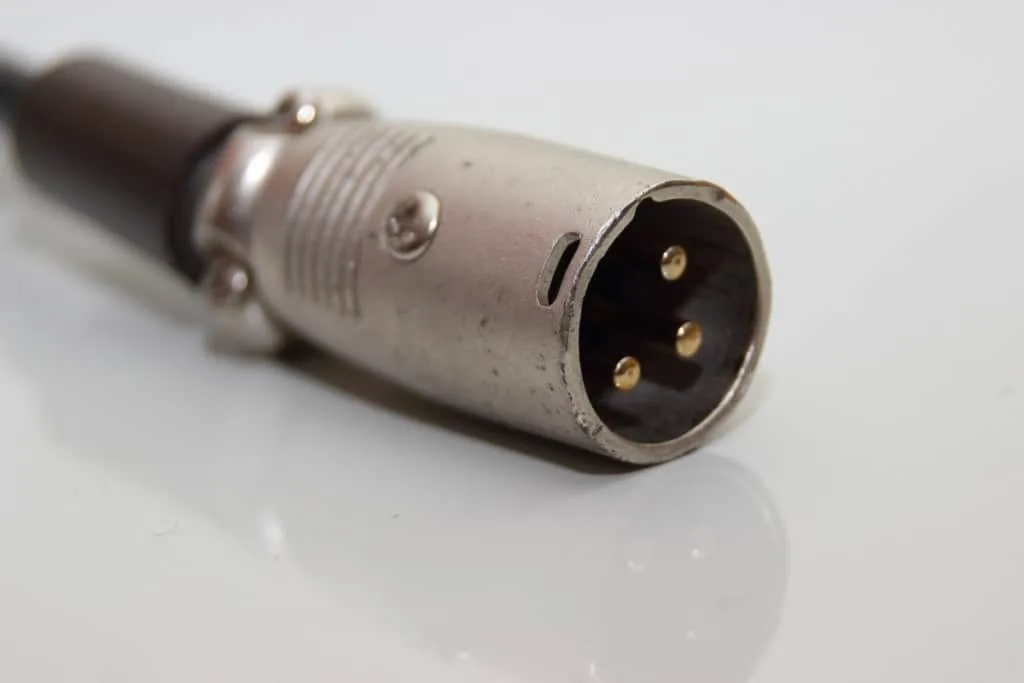XLR cables are vital if you want to record using a microphone. Compared to RCA and Jack cables, they are significantly more expensive. Why this is the case is a subject that requires further explanation.
Why are XLR cables so expensive?
The two main factors that make XLR cables expensive are necessity and quality. It isn’t possible to record using most microphones or to send balanced outputs to speakers and monitors without XLR cables. Therefore, manufacturers can charge more knowing that musicians or recording engineers have no choice but to pay a little extra.
XLR is considered to be the industry standard for recording and outputting audio.
These cables are used in every recording studio, broadcasting environment, or radio station. Their universal popularity is largely down to the fact that they carry balanced audio, which means they produce the cleanest and clearest sound possible. This reason, amongst others, also contributes to their high cost.

What Makes An XLR Cable So Expensive?
XLR is an abbreviation that describes the three main components of the cable. X stands for X Connector, L stands for Locking Connector, and R stands for Rubber Boot. The latter is commonly not included on modern XLR cables, but for convenience’s sake, the name has remained the same.
As stated in the opening paragraph, the two main factors that make XLR cables justifiably expensive are necessity and quality. When it comes to high-quality inputs, XLRs simply perform better than any other cable that’s been invented.
Almost all microphones, barring small USB mics, will only have an XLR input. Unlike jack cables using for electric guitars, XLRs send a balanced signal, which isolates the sound source and doesn’t produce any unwanted noises.
Although they are unquestionably expensive, especially compared to other audio cables, XLRs are worth it. There’s simply no alternative that can transmit such a clean audio signal. There are technical reasons for this, which I will explain in detail later in this article.
A popular, high-quality choice of XLR cable is made by Mogami, Check out Mogami XLR cables here on Amazon.
Another quality of XLR cables that adds to the overall cost is their durability.
Guitar cables break all the time, even when the utmost care is taken to coil them up after each practice session. XLR cables are much less likely to stop working, thanks to the robust nature of their design and the solidity of the end connector.
In addition to recording, XLR cables are heavily used onstage.
Their superior sound quality is essential for making sure each microphone produces a clean output. They also come in a variety of sizes, making them ideal for either long cable stretches using adapters, or for shorter distances. This versatility is another reason for their expensive price tags.
XLR Signal Quality vs Quantity
In an audio system, the signal can degrade at several stages. By far the most common cause of signal degradation is the microphone cable. Although, as I’ve stated, XLR cables all provide a balanced output, that doesn’t mean that every one performs to the same standard.
There are plenty of cheap XLR cables available online. The issue is, these low-priced cables often cause you more problems than they solve. A good quality XLR cable is expensive, but the money you are likely to save in the long run from not needing to replace it after a short time makes for a worthy investment.
It might seem as simple as just plugging any old XLR cable into a microphone, then into a preamp or interface. With a good quality cable, it is that easy. However, the cheap and poorly-made options are likely to result in electronic hum, interference, and cutting out, usually in the middle of a stellar guitar or vocal take!

What’s The Difference Between Good Quality, Expensive XLR Mic Cable, And A Cheaper, Less Reliable One?
The majority of microphones operate at low voltages. This means that the signal needs to be amplified significantly so that it can make its way through the line level of an audio rig.
By the time the signal reaches a preamp or direct input, the XLR cable itself becomes amplified in addition to the signal. In the same way, any noise that is produced within the cable is also amplified.
So if you are using a poor quality XLR cable, the sub-par inner components will likely cause unwanted electronic hum, which then gets amplified and is audible alongside the microphone’s output.
Let’s briefly get into the technicalities.
A quality XLR cable takes the signal from the mic, which is received by two wires. One of these wires is then inverted by 180 degrees, and then the signal is re-inverted and combined with the other. If interference or electronic noise occurs during this transmission, this is removed by phase cancellation.
This is why XLR cables are considered to be the gold-standard in the field of audio.
XLR cables are unrivaled in their ability to minimize unwanted noise, and therefore to produce the cleanest, most accurate signal of any cable type. A guitar cable doesn’t require this ability, because the signal doesn’t need as much amplification as a microphone.
Balanced vs. Unbalanced: What’s The Difference?
One of the main reasons that XLR cables are so expensive is because they produce a balanced electrical signal. To summarize the difference between balanced and unbalanced cables, refer to the table below.
| Balanced | Unbalanced |
| Produces minimal electronic noise | Susceptible to electronic noise |
| Amplifies low-voltage signals | Suitable for high-voltage signals |
| Can be used for long cable runs | Only suitable for short cable runs |
| Used mainly for microphones | Used mainly for guitars |
Take a look at this video that goes into detail on this subject.
There are three wires that a balanced electrical signal runs along. These are:
- A positive leg
- A negative leg
- A ground
Both the positive leg and negative legs transport the same signal, but the polarities are opposite to each other. If any electric noise enters the cable run, it will usually be present in both of the legs.
XLR cables are used for long cable runs because they can interact with the interface, preamp, or mixer that the signal runs into, and flip one of the signals, putting the two back into polarity with each other.
In comparison to an unbalanced jack cable, this results in a much cleaner sound quality and significantly less noise interference. This explains why balanced XLRs are generally much more expensive than other cables.
The Different Types Of XLR Cables
There are multiple varieties of XLR cables, some being more expensive than others. Generally speaking, the more pins an XLR cable has, the more it will cost. Each of these types are used for different purposes. These types consist of:
- XLR3
- XLR4
- XLR5
- XLR6
- XLR7
- PDN
The number simply indicates the number of pins that the particular XLR cable has.
XLR3 connectors are the most common type. These three-pin cables are the industry standard when it comes to balanced audio signals. They are used with most professional mics, and to connect powered speakers with mixers or interfaces. Additionally, they are used for lighting equipment.
XLR4 connectors are also used in several ways. These include intercom headsets and video cameras. XLR5 connectors are also used for some lighting appliances. 6-pin and 7-pin XLRs are less common and are used for more niche purposes.

XLR Cable Length
Another reason that XLR cables are so expensive is their ability to span long lengths and cater to extensive cable runs.
This 50ft XLR is a prime example. Long cables are likely to pick up undesirable noises and interference is pretty much inevitable.
I have written an article called “how long can XLR cables be” you can read it here.
If you were to use an extra-long jack cable, the signal would be marred by electronic noise and interference, making the output sound messy. Conversely, an XLR cable can stretch long distances while still preserving the sound quality, hence the heftier price tag.
In theory, an XLR cable could run for 1000ft without having any problems regarding signal quality. This may seem staggering, but it is possible, providing the cable had the necessary components and was boosted and shielded.
Alternatively, there are mini-XLR cables available for shorter distances.
These come in useful when recording in a small space. They are also used for connecting speakers to interfaces or mixers so that the inconvenience of long cables can be avoided. The varying length of XLR cables compared to other audio cables certainly plays a role in why they are so expensive.
Related Questions
What’s the difference between XLR and TRS cables?
Although XLR and TRS cables are both balanced, XLRs are grounded as soon as they are connected to a microphone, so there are no unexpected pops or electrical noises. In comparison, TRS cables do not ground upon connection making them susceptible to noise.
Why don’t guitars use XLR cables?
Guitars don’t use XLR cables because they don’t require balanced connectors. They produce an unbalanced output, so using an XLR cable would provide no benefits compared to a standard 6.35mm jack cable.
Can XLR cables be used with condenser mics?
XLR cables are the most common connectors used for condenser mics. There are a minority of condensers that use USB connectivity, but in general, XLR is preferred due to its clear signal and ability to facilitate phantom power.
I have also written an article called ” Can XLR cables be used for speakers” You can read it here.
I hope this article explains why XLR cables are more expensive than standard cables. Thanks for stopping by and enjoy your recording.
